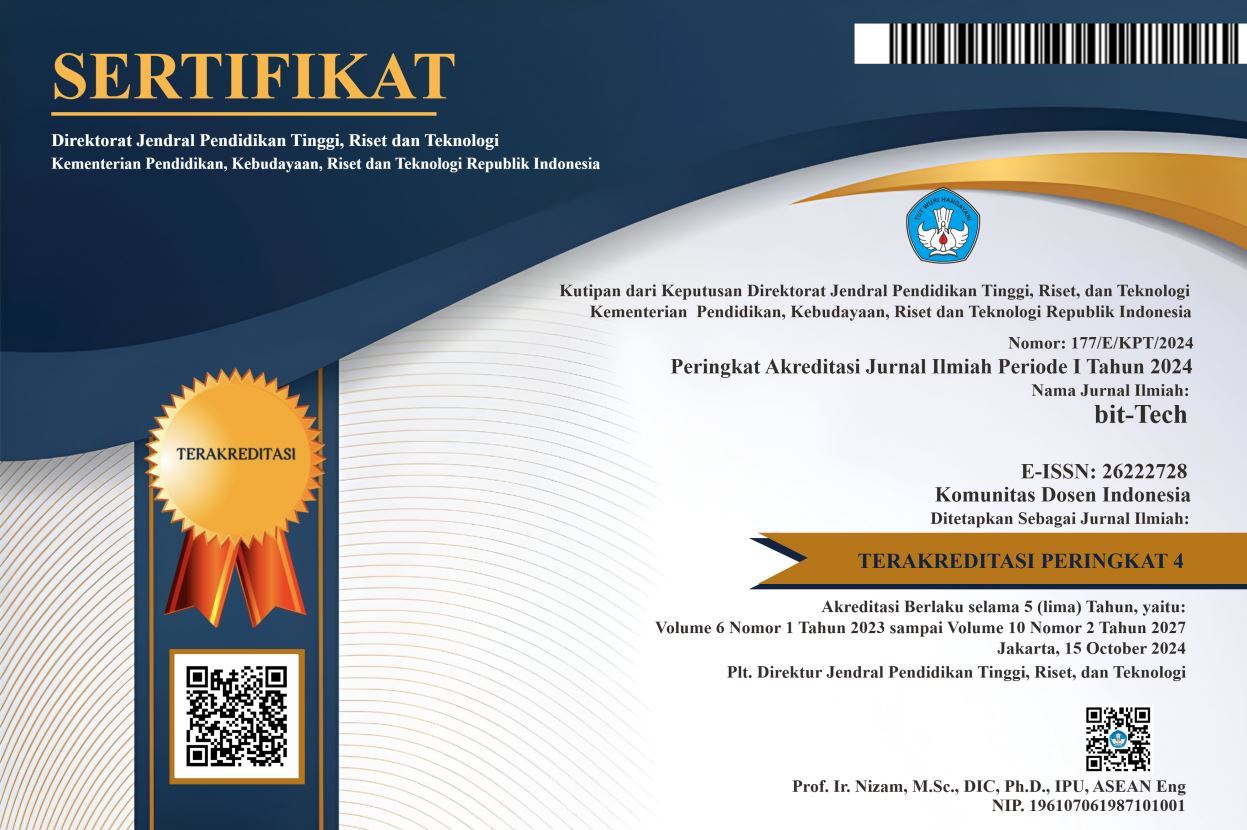Designing Prototype of Volume Detector for Medical Oxygen Cylinder Using NodeMCU ESP8266
DOI:
https://doi.org/10.32877/bt.v6i2.980
Keywords:
Early Notification, Internet Of Things, Nodemcu Esp8266, Oxygen Cylinder, Volume Detector
Abstract
The COVID-19 pandemic posed significant challenges to the healthcare sector, particularly due to the imbalance between patient numbers and available medical staff, resulting in difficulties during emergencies. One such challenge was the prompt replacement of oxygen cylinders. Leveraging Internet of Things (IoT) technology, we developed a prototype oxygen cylinder volume detector aimed at providing early notifications to healthcare professionals. This prototype incorporates the NodeMCU ESP8266, equipped with an Infrared (IR) Obstacle Sensor. The sensor communicates with a relay to activate an MP3 module, delivering audible alerts. Furthermore, the NodeMCU ESP8266 system integrates CTBot to send text notifications through the Telegram application to the nearest healthcare personnel. Visual alerts are also provided through red LED lights attached to the cylinders, indicating which oxygen cylinder is approaching depletion. Comprehensive testing validated the proper functionality of all system components. This innovative oxygen cylinder detector prototype is designed to streamline healthcare worker and nurse workflows by offering quicker access to accurate information regarding the status of medical oxygen cylinders. Not only does this enhance patient care efficiency, but it also ensuring the availability of oxygen is crucial for critical patients.
Downloads
References
J. M. Walter, T. C. Corbridge, and B. D. Singer, “Invasive Mechanical Ventilation,” South Med J, vol. 111, no. 12, pp. 746–753, Dec. 2018, doi: 10.14423/SMJ.0000000000000905.
S. B. Brosnahan, A. H. Jonkman, M. C. Kugler, J. S. Munger, and D. A. Kaufman, “COVID-19 and Respiratory System Disorders,” Arterioscler Thromb Vasc Biol, vol. 40, no. 11, pp. 2586–2597, Nov. 2020, doi: 10.1161/ATVBAHA.120.314515.
A. Hvarfner et al., “Oxygen provision to severely ill COVID-19 patients at the peak of the 2020 pandemic in a Swedish district hospital,” PLoS One, vol. 17, no. 1, p. e0249984, Jan. 2022, doi: 10.1371/journal.pone.0249984.
Clevelend Clinic, “Oxygen Therapy,” https://my.clevelandclinic.org/health/treatments/23194-oxygen-therapy.
B. H. Katira, “Ventilator-Induced Lung Injury: Classic and Novel Concepts,” Respir Care, vol. 64, no. 6, pp. 629–637, Jun. 2019, doi: 10.4187/respcare.07055.
B. Rahmat, “Telemonitoring Gas Medis,” in Seminar Nasional Widya Husada 1, Semarang: Stikes Widya Husada, 2019, pp. 32–34.
N. H. Wijaya, B. Untara, and I. Khoirunnisa, “Monitoring Tekanan Gas Medis Pada Instalasi Gas Medis Rumah Sakit,” Medika Teknika : Jurnal Teknik Elektromedik Indonesia, vol. 1, no. 1, 2019, doi: 10.18196/mt.010104.
R. I. Puspitasari, D. Titisari, and L. Lamidi, “Development of Monitoring Parameters of Oxygen Concentration, Oxygen Flow Rate, Temperature and Humidity in IoT-Based CPAP Bubble (Oxygen and Humidity Concentration),” Jurnal Teknokes, vol. 16, no. 2, 2023.
A. Hendryani, V. Nurdinawati, and N. Dharma, “Desain Manifold dengan Monitoring Tekanan untuk Pertukaran Otomatis Tabung Gas Oksigen Medis di Rumah Sakit,” Teknik, vol. 42, no. 1, pp. 45–51, 2021.
H. S. Azhari Lubis, I. R. Munthe, and R. Pane, “Infus Desain Notifikasi Dengan Aplikasi Media Sosial Berbasis Internet of Things (IOT),” Jurnal Teknik Informatika UNIKA Santo Thomas, pp. 117–125, Jul. 2021, doi: 10.54367/jtiust.v6i1.1286.
A. H. Abdulwahid, “Modern Application of Internet of Things in Healthcare System,” International Journal of Engineering Research and Technology, vol. 12, no. 4, pp. 464–499, 2019.
T. R. Wanasinghe, R. G. Gosine, L. A. James, G. K. I. Mann, O. de Silva, and P. J. Warrian, “The Internet of Things in the Oil and Gas Industry: A Systematic Review,” IEEE Internet Things J, vol. 7, no. 9, pp. 8654–8673, Sep. 2020, doi: 10.1109/JIOT.2020.2995617.
Make-It.ca, “NodeMCU ESP8266 Detailed Review,” https://www.make-it.ca/nodemcu-details-specifications.
A. Verdejo Espinosa, J. L. Lopez Ruiz, F. Mata Mata, and M. E. Estevez, “Application of IoT in Healthcare: Keys to Implementation of the Sustainable Development Goals,” Sensors, vol. 21, no. 7, p. 2330, Mar. 2021, doi: 10.3390/s21072330.
W. Wijayanto, A. P. Nevita, and H. A. Munawi, “Perancangan Sistem Otomatisasi Hand Sanitizer Berbasis Sensor Infrared Barrier Module,” Nusantara of Engineering (NOE), vol. 4, no. 1, 2021.
TeachEngineering.org, “Design Step 1: Identify the Need (Hands-On Activity),” https://www.teachengineering.org/activities/view/cub_creative_activity1.
Downloads
Published
How to Cite
Issue
Section
License
Copyright (c) 2023 bit-Tech : Binary Digital - Technology

This work is licensed under a Creative Commons Attribution-ShareAlike 4.0 International License.
I hereby assign and transfer to bit-Tech all exclusive copyright ownership rights to the above work. This includes, but is not limited to, the right to publish, republish, downgrade, distribute, transmit, sell, or use the work and other related materials worldwide, in whole, or in part, in all languages, in electronic, printed, or any other form of media, now known or hereafter developed and reserves the right to permit or license a third party to do any of the above. I understand that this exclusive right will belong to bit-Tech from the date the article is accepted for publication. I also understand that bit-Tech, as the copyright owner, has sole authority to license and permit reproduction of the article. I understand that, except for copyright, any other proprietary rights associated with the work (e.g. patents or other rights to any process or procedure) must be retained by the author. In addition, I understand that bit-Tech permits authors to use their papers in any way permitted by the applied Creative Commons license.


 DOI :
DOI :
 Abstract views: 105
/
Abstract views: 105
/  PDF downloads: 91
PDF downloads: 91











